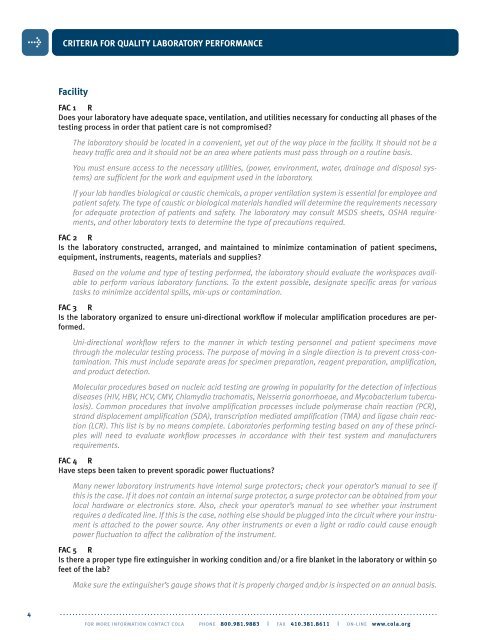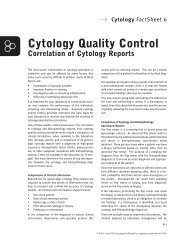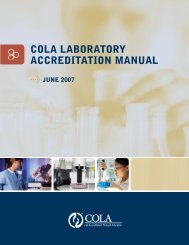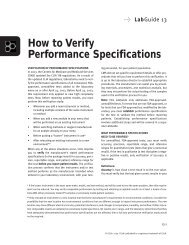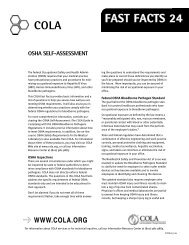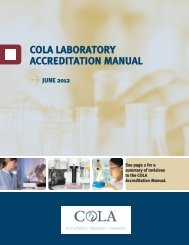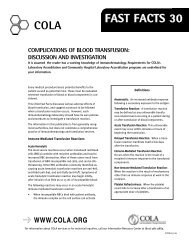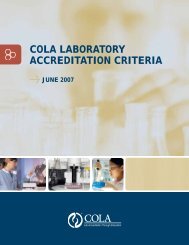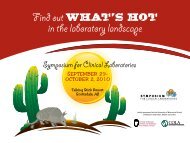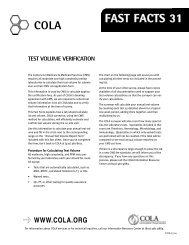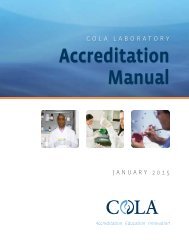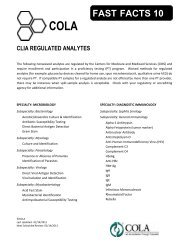#06-5558 Accrd Manual V7 - COLA
#06-5558 Accrd Manual V7 - COLA
#06-5558 Accrd Manual V7 - COLA
- No tags were found...
You also want an ePaper? Increase the reach of your titles
YUMPU automatically turns print PDFs into web optimized ePapers that Google loves.
CRITERIA FOR QUALITY LABORATORY PERFORMANCEFacilityFAC 1 RDoes your laboratory have adequate space, ventilation, and utilities necessary for conducting all phases of thetesting process in order that patient care is not compromised?The laboratory should be located in a convenient, yet out of the way place in the facility. It should not be aheavy traffic area and it should not be an area where patients must pass through on a routine basis.You must ensure access to the necessary utilities, (power, environment, water, drainage and disposal systems)are sufficient for the work and equipment used in the laboratory.If your lab handles biological or caustic chemicals, a proper ventilation system is essential for employee andpatient safety. The type of caustic or biological materials handled will determine the requirements necessaryfor adequate protection of patients and safety. The laboratory may consult MSDS sheets, OSHA requirements,and other laboratory texts to determine the type of precautions required.FAC 2 RIs the laboratory constructed, arranged, and maintained to minimize contamination of patient specimens,equipment, instruments, reagents, materials and supplies?Based on the volume and type of testing performed, the laboratory should evaluate the workspaces availableto perform various laboratory functions. To the extent possible, designate specific areas for varioustasks to minimize accidental spills, mix-ups or contamination.FAC 3 RIs the laboratory organized to ensure uni-directional workflow if molecular amplification procedures are performed.Uni-directional workflow refers to the manner in which testing personnel and patient specimens movethrough the molecular testing process. The purpose of moving in a single direction is to prevent cross-contamination.This must include separate areas for specimen preparation, reagent preparation, amplification,and product detection.Molecular procedures based on nucleic acid testing are growing in popularity for the detection of infectiousdiseases (HIV, HBV, HCV, CMV, Chlamydia trachomatis, Neisserria gonorrhoeae, and Mycobacterium tuberculosis).Common procedures that involve amplification processes include polymerase chain reaction (PCR),strand displacement amplification (SDA), transcription mediated amplification (TMA) and ligase chain reaction(LCR). This list is by no means complete. Laboratories performing testing based on any of these principleswill need to evaluate workflow processes in accordance with their test system and manufacturersrequirements.FAC 4 RHave steps been taken to prevent sporadic power fluctuations?Many newer laboratory instruments have internal surge protectors; check your operator’s manual to see ifthis is the case. If it does not contain an internal surge protector, a surge protector can be obtained from yourlocal hardware or electronics store. Also, check your operator’s manual to see whether your instrumentrequires a dedicated line. If this is the case, nothing else should be plugged into the circuit where your instrumentis attached to the power source. Any other instruments or even a light or radio could cause enoughpower fluctuation to affect the calibration of the instrument.FAC 5 RIs there a proper type fire extinguisher in working condition and/or a fire blanket in the laboratory or within 50feet of the lab?Make sure the extinguisher’s gauge shows that it is properly charged and/or is inspected on an annual basis.4. . . . . . . . . . . . . . . . . . . . . . . . . . . . . . . . . . . . . . . . . . . . . . . . . . . . . . . . . . . . . . . . . . . . . . . . . . . . . . . . . . . . . . . . . . . . . . . . . . . . . . . . . . . . . . . . . . . . . . . . .FOR MORE INFORMATION CONTACT <strong>COLA</strong> PHONE 800.981.9883 | FAX 410.381.8611 | ON-LINE www.cola.org


